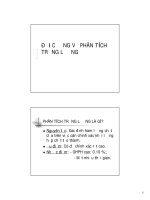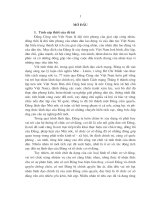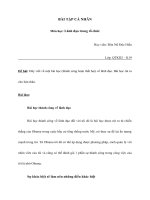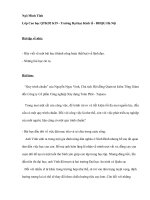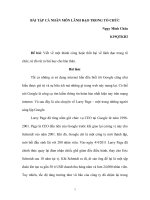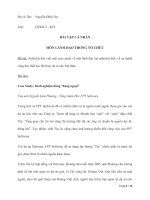Đại cương về lãnh đạo trong tổ chức chapter 7 leader follower relations
Bạn đang xem bản rút gọn của tài liệu. Xem và tải ngay bản đầy đủ của tài liệu tại đây (475.79 KB, 39 trang )
.c
om
an
co
ng
Chapter 7
cu
u
du
o
ng
th
Leader–Follower
Relations
Copyright © 2010 by South-Western/Cengage Learning
All rights reserved.
CuuDuongThanCong.com
PowerPoint Presentation by Rhonda S. Palladi
Georgia State University
/>
.c
om
Evolution of the Dyadic Theory
Dyadic theory
co
ng
Is an approach to leadership that attempts to explain
why leaders vary their behavior with different followers
du
o
ng
th
an
Dyadic theorists focus on the development and
effects of separate dyadic relationships between
leaders and followers
Leaders provide support for self-worth
cu
u
A leader’s support for a follower’s actions and ideas
A leader building follower’s confidence in his or her
ability, integrity, and motivation
A leader paying attention to the follower’s feelings and
needs
2
CuuDuongThanCong.com
/>
.c
om
Dyadic Approach:
Stages of Development
Vertical Dyadic
Linkage (VDL) Theory
co
ng
Individualized leader–follower
interactions creating in-groups
and out-groups
du
o
ng
th
an
Leader–Member
Exchange (LMX)
cu
u
Team Building
Systems and
Networks
Focus is on the quality of each dyad
and its effects on organizational
outcomes over time
Leaders can aspire to build
positive relationships with all
followers, not just a few
special individuals
Creating positive dyadic relationships
across traditional boundaries to
include a larger network of
participants
3
CuuDuongThanCong.com
/>
.c
om
Vertical Dyadic Linkage
(VDL) Theory
th
an
co
ng
Examines how leaders form one-on-one
relationships with followers, and how these often
create in-groups and out-groups within the
leader’s work unit
In-group
u
Out-group
du
o
ng
Includes followers with strong social ties to their leader
in a supportive relationship characterized by high
mutual trust, respect, loyalty, and influence
cu
Influences followers with few or no social ties to their
leader, in a strictly task-centered relationship
characterized by low exchange and top-down influence
4
CuuDuongThanCong.com
/>
ng
co
an
th
ng
cu
u
Participate in important decision making
Are given added responsibility
Have greater access to the leader
Experience greater support and positive influence from the
leader
Reciprocity
High exchange
Granted special favors from the leader
Mutual reinforcement based on common needs and
interests
More likely to share with own group members than with
members of other groups
du
o
.c
om
Characteristics of In-Groups
5
CuuDuongThanCong.com
/>
.c
om
Characteristics of Out-Groups
cu
u
du
o
ng
th
an
co
ng
Are managed according to the
employment contract requirements
Receive little inspiration, encouragement,
or recognition
Do not experience positive relationships
and influence
6
CuuDuongThanCong.com
/>
.c
om
Discussion Question #1
cu
u
du
o
ng
th
an
co
ng
In your opinion, can a leader
maintain a personal friendship
with some members of his or her
work group or team without
creating the perception of ingroups (those in his or her social
circle) and out-groups (those
outside his or her social circle)?
7
CuuDuongThanCong.com
/>
ng
.c
om
Discussion Question #2
cu
u
du
o
ng
th
an
co
What should a leader do to dispel
any notion or misperception that
there are in-groups and outgroups in his or her work unit?
Example: Pastor Osteen
8
CuuDuongThanCong.com
/>
.c
om
Leader–Member Exchange
(LMX) Theory
ng
Is the quality of the exchange relationship
between an employee and his or her superior
th
u
du
o
Face-to-face leader–member interaction is
critical in organizations
cu
Leaders do not interact with all followers equally, which
ultimately results in the formation of LMXs that vary in quality
ng
an
co
Assumes that leaders have limited amounts of social,
personal, and organizational resources, and tend to
distribute them among followers selectively
9
CuuDuongThanCong.com
/>
.c
om
High-Quality LMX Relationships
vs. Low-Quality LMX Relationships
ng
th
an
co
Better social support
More resources
More guidance for career development
Greater follower input in decision making
Greater negotiating latitude
du
o
ng
High-quality LMX relationships are characterized
by:
cu
u
Low-quality LMX relationships are characterized
by:
Less support
More formal supervision
Little or no involvement in decision making
10
CuuDuongThanCong.com
/>
.c
om
Team Building
The emphasis is on forming relationships with all group
members, not just with a few special individuals
It is not possible to treat all followers exactly the same
Each person must perceive that he or she is an
important and respected member of the team rather
than a non-entity
u
cu
du
o
ng
th
an
co
ng
Involves a primary concern to motivate a group
of individuals to work together to achieve a
common objective, while alleviating any
conflicts or obstacles that may arise while
striving toward that objective
11
CuuDuongThanCong.com
/>
.c
om
Systems and Networks
du
o
ng
th
an
co
ng
There is a noticeable trend of
organizations seeking and getting
involved in a variety of collaborative
agreements for the purposes of entering
new markets and gaining innovations or
new products
cu
u
By collaborating, organizations hope to
exchange strengths with others, which will
allow all partners to develop timely,
innovative, synergistic solutions to complex
problems they could not address on their
own
CuuDuongThanCong.com
/>
12
.c
om
Systems and Networks (cont.)
cu
u
du
o
ng
th
an
co
ng
A systems-oriented prospective focuses
on how the quality of the LMX relationship
affects followers at the interpersonal,
group, and organizational levels
Proponents of the systems and networks
view contend that leader relationships are
not limited to followers, but include
peers, customers, suppliers, and other
relevant stakeholders in the collectives of
workgroups and organization-wide
networks
13
CuuDuongThanCong.com
/>
.c
om
Leader–Member Exchange Theory
cu
u
du
o
ng
th
an
co
ng
Leaders form high-quality social exchanges
(based on trust and liking) with some members
and low-quality economic exchanges with others
that do not extend beyond the employment
contract
The quality of LMX affects employees’ work
ethics, productivity, satisfaction, and perceptions
There is a sense among followers in the
exchange relationship to reciprocate their
leader’s trust and liking through ―citizenship
behaviors‖ and excellent performance
14
CuuDuongThanCong.com
/>
.c
om
The Influence of LMX
on Follower Behavior
an
co
ng
The special relationship with in-group followers
creates certain obligations and constraints for
the leader
To maintain the relationship, the leader must:
cu
u
du
o
ng
th
Pay attention to in-group members
Remain responsive to their needs and feelings
Rely more on time-consuming influence methods such
as persuasion and consultation
Not resort to coercion or heavy-handed use of authority
15
CuuDuongThanCong.com
/>
.c
om
The Influence of LMX
on Follower Behavior (cont.)
u
du
o
ng
th
Helping with a follower’s career
Giving special favors
Allowing participation in decision making
Delegating greater responsibility and authority
Sharing more information
Assigning interesting and desirable tasks
Giving tangible rewards
cu
an
co
ng
The basis for establishing a deeper exchange
relationship with in-group members is the
leader’s control over outcomes that are desirable
to the followers, which include:
16
CuuDuongThanCong.com
/>
.c
om
The Influence of LMX
on Follower Behavior (cont.)
th
an
co
Be loyal to the leader
Be more committed to task objectives
Work harder
Share some of the leader’s administrative duties
ng
ng
In return for these benefits, in-group members
are expected to:
cu
u
du
o
To the leader this also represents social capital
that gives him or her power and influence over
followers
Unless this cycle of behavior is interrupted, the
relationship is likely to develop to a point where
there is a high degree of mutual dependence,
17
support, and loyalty
CuuDuongThanCong.com
/>
.c
om
The Three-Stage Process for Developing
Positive LMX Relations
Stage 1
cu
u
du
o
ng
th
an
co
ng
The leader and follower conduct themselves
as strangers
The leader and follower test each other to
identify what kinds of behavior are
acceptable
Each relationship is negotiated informally
between each follower and the leader
18
CuuDuongThanCong.com
/>
.c
om
The Three-Stage Process for Developing
Positive LMX Relations (cont.)
Stage 1 (cont.)
ng
Involves:
co
– Impressions management
– Ingratiation
ng
th
an
Is a follower’s effort to project a favorable image in
order to gain an immediate benefit or improve a longterm relationship with the leader
du
o
Is the effort to appear supportive, appreciative, and
respectful
cu
u
– Self-promotion
Is the effort to appear competent and dependable
19
CuuDuongThanCong.com
/>
.c
om
Discussion Question #3
cu
u
du
o
ng
th
an
co
ng
What do you say to those who
argue that tactics used by
followers to get noticed by their
leader (such as impressions
management, ingratiation, and
self-promotion) are shameful and
self-serving and should be
avoided?
20
CuuDuongThanCong.com
/>
.c
om
The Three-Stage Process for Developing
Positive LMX Relations (cont.)
Stage 2
cu
u
du
o
ng
th
an
co
ng
The leader and follower become acquainted
They further refine the roles they will play
together
Mutual trust, loyalty, and respect develop
between leader and follower
Relationships that do not move beyond Stage
1 may deteriorate and remain at the level of
an out-group
21
CuuDuongThanCong.com
/>
.c
om
The Three-Stage Process for Developing
Positive LMX Relations (cont.)
Stage 3
cu
u
du
o
ng
th
an
co
ng
The roles reach maturity
Exchange based on self-interest is
transformed into mutual commitment to the
mission and objectives of the work unit
The end result of the life cycle model of LMX
relationships is the creation of actual and
perceived differences between in-group and
out-group members
22
CuuDuongThanCong.com
/>
.c
om
Factors that Determine LMX Quality
Followers’ attributes
Proactive followers:
th
an
co
ng
– Show initiative even in areas outside their immediate
responsibility
– Possess a strong sense of commitment to work unit goals
– Show a stronger sense of responsibility for unit success
u
du
o
Show support
Delegate more
Allow greater discretion
Engage in open communication
Encourage mutual influence between themselves and
their followers
cu
–
–
–
–
–
ng
These follower attributes influence leaders to:
– From the follower’s perspective, leaders that are
perceived to be competent, experienced, fair, and23
honest are more likely to be supported
CuuDuongThanCong.com
/>
.c
om
Effective Leader–Follower Feedback
du
o
ng
th
an
co
ng
Many leaders avoid confronting belowaverage performing followers
Can degenerate into personal conflict
May fail to deal with the underlying
problem
Correcting deficiencies can help the
follower improve
cu
u
Example – Nurse/student who wanted to
perform better but was not given the
feedback and support to do so.
Must be done so that the leader–follower
relationship is preserved
CuuDuongThanCong.com
/>
24
.c
om
Guidelines for Effective
Leader Feedback
Pre-feedback—Leader should:
th
an
co
ng
Remind self to stay calm and professional
Gather accurate facts on follower
performance
Remind self to avoid rush to judgment
cu
u
du
o
ng
Remember the attribution theory!!!
25
CuuDuongThanCong.com
/>
